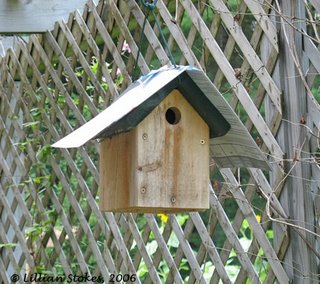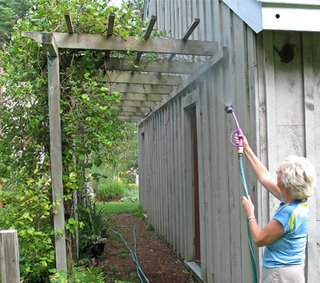and bathe.
Orange halves are a refreshing treat in warm weather for this Gray Catbird.
An extra roof cools off the bird house above and below.
This baby American Robin cooled off the only way it knows how, by panting. Birds have no sweat glands and so cool themselves by rapid respiration with their mouths open.
I used the mister setting on the hose to cool off the robin nest by misting the air and foliage above.
Hummingbird Feeder with shade roof.
The weather has been crazy, ranging from one extreme to another. Here in NH we just had 90 degree summer weather, now it has cooled off a little. Much more hot weather is coming as we go into summer. So when the temperature climbs, here's some tips to keep your feathered buddies cool:
1. Bird baths, bird baths, bird baths! Birds need water to bath and drink in hot weather so buy a bird bath. You can even use any wide flat container for a bird bath, such as the lid of a trash can or a large saucer that it used under a flowerpot.
2. Choose a bird bath that is shallow and has a non-slip surface. Small birds do not like to bathe in deeper water. You can add flat rocks to a bird bath that is too deep in order to create a shallow ledge for small birds to land on to drink and bathe.
3. Add a dripper, bubbler or to your bird bath. The sound of moving water will be a magnet for the birds and alert them to the presence of a water source.
4. Keep the water in your bird bath cool by adding ice cubes several times a day, or refilling the bird bath with a hose. You can also put out refreshing treats like cold orange halves which many birds, such as orioles and Gray Catbirds, will enjoy.
5. Birds will feel safer if the bird bath is placed in a more open area so no predators can hide nearby. Provide a stake or branch placed in the ground near the bird bath, if no landing places exist near it, so birds have a place to wait their turn at the bath.
6. Air condition your bird houses by adding a second roof for shade. We nail on a piece of plywood, using long nails and only nailing them part way into the original roof. This leaves an air space between the two roofs of about an inch. The second roof shades the first roof plus the airspace between the roofs acts as an insulator, keeping the bird house cooler. In some cases we have just shaded the roof of a bird house with piece of cardboard.
7. Misters are coolers. Misters can be bought to attach to a bird bath, or clip to shrubs near a bath. They spray a fine mist that birds can fly though, or rub against the wet shrubbery. Hummingbirds will often fly through misters, or even a garden sprinkler.
8. Use a mister on a hose. Our hose has a mist setting on the nozzle. We have misted the foliage and area above a robin nest to cool off the babies in extreme heat.
9. Think Shade. Birds will seek out shady areas and lie low in the worst heat of the day. If you do not have shade on your property plant some shade trees and big shrubs. Place bird feeders in a shady area during summer.
10. Shade hummingbird feeders. Place them in shade. Some feeders, such as our Stokes Select Jubilee Hummingbird Feeder, pictured above, comes with its own shade/rain roof, including and ant moat on the roof. You can also buy baffle-type shields and hang them above a feeder. Don't forget to change your hummingbird nectar solution every 2 days in really hot weather.
And tips for you....
Stay out of the sun and heat in the middle of the day, wear a hat and sunscreen when you do go out and, at the end of the day, after you have taken care of the birds, relax in a shady place, get out your binos and The New Stokes Field Guide to Birds: Eastern or Western Region, watch your birds and have a cold beer, daiquiri, margarita, or some Prosecco,,,aaahhh!


















